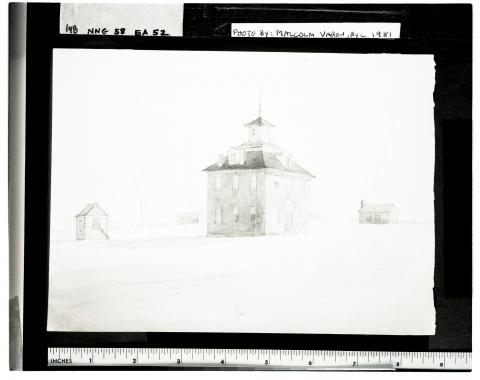March 16, 1833
16 March:[Page 1:201] After we had had breakfast and our things had been loaded on a wagon, Mr. Bodmer and I mounted the two light bays of our landlord, Arthur, and we rode ahead of the wagon in which Dreidoppel rode. M2Departure from New Harmony. In the morning at seven thirty, [——]°; at noon [——]°.The morning was glorious and very warm; the sunshine was pleasant. We puffed our cigarros as we rode from Harmony up the hills that surround the low ground along the Wabash, on which that place is located.
Tall woodlands soon surrounded us on all sides, and in the high maples, oaks, and tulip trees, robins (Turdus migratorius), turtledoves (dove, Columba carolinensis), woodpeckers, and several other birds sang their morning songs. In Europe the dove’s gentle call is not heard until later [in the year], when the woods are green. In the lower thickets, pawpaw trees (Annona), Rubus etc., cardinals, towhee buntings (Fringilla erythrophthalma), Fringilla pennsylvanica, and hyemalis were abundant. Many trees already had buds. The dogwood (Cornus florida), which grows profusely everywhere here, had thick buds, as is the case with many tree types; the large, beautiful white blossoms appear before its foliage. The hazel bushes (Corylus americana) had long catkins.
 At first we followed the road I had recently traveled with Mr. Say. We passed Rush Creek. On the hills beside it grow numerous huge sugar maples (Acer saccharinum, nigrum), which were now furnished with tubes for tapping the sap. Below them stands a small wooden trough, in which we could see the weakly sweetish sap. Elder is preferred for making the tubes, but other kinds of wood are also used.
At first we followed the road I had recently traveled with Mr. Say. We passed Rush Creek. On the hills beside it grow numerous huge sugar maples (Acer saccharinum, nigrum), which were now furnished with tubes for tapping the sap. Below them stands a small wooden trough, in which we could see the weakly sweetish sap. Elder is preferred for making the tubes, but other kinds of wood are also used.
The sap was not flowing today, but it had flowed earlier. This occurs in spring, especially when hot days follow cold, frosty nights. Somewhat farther along in the forest we came upon a complete sugar camp, a hut in which the sap is boiled down. Maples became more and more abundant here, and the hut, in which four kettles for sap boiling were embedded in a pit in the floor, also contained large troughs, in which the sap from the small tree-troughs is collected (see Mr. Bodmer’ s sketch).

Such a setup is called a sugar camp, and the quantity of sugar obtained depends on the number of maples growing in such places. Some camps produce 1,000 pounds of sugar a year, others 300–500, etc. It is crystallized in loaves, and its unadulterated taste is sweeter than any other sugar, but [it is]brown [in color]. It sold for ten cents a pound in Harmony and Mount Vernon.
It sold for ten cents a pound in Harmony and Mount Vernon. Mr. Bodmer We refreshed ourselves with some of the maple sap in the troughs and[Page 1:202] with it ate the things Mr. Say had given us as we left. Even our horses, familiar with these forests, eagerly drank the sap, and while Mr. Bodmer, sitting on an old, moss-covered tree trunk, sketched the hut, the wagon with the baggage arrived and we continued our journey.
In the isolated cultivated fields scattered throughout the forest, we saw men occupied with burning off the wood. Often the planters’ habitations in this region do not even have windows; light comes in only through the opened door. From the outside one sees the large, wide bed. Near it is the fireplace with a fire burning in it. Instead of a window, they often have an opening with merely a shutter; glass windows are quite a luxury. Near some dwellings we saw several sheep; pigs [were] everywhere in large numbers. The cattle looked poor because of the winter. Almost nothing but Indian corn is planted; oats only here and there.
The road, which ran between the hills and the small valleys following endlessly one after the other, was [here] rather good. From puddles and small swampy pools in the valleys, we heard the sound of a small greenish gray tree frog (Hyla No. [— —]), which we captured. We had not previously seen it. As soon as we approached the puddles, these small creatures plunged into the mud and clouded the water. They make a noise that is audible for a considerable distance in these woods because of their numbers. Redheaded woodpeckers, as well as the other kinds of woodpeckers, were all around in large numbers—especially the former. When it flies, it resembles a butterfly. Like the head, the broad white undersurface is visible at a great distance. Many butterflies were already flying about today, especially Papilio antiopa. Several gray squirrels enlivened the tall, slender trunks in the forest.
We reached Big Creek, a rushing brook, which now flowed rather low within its banks and over which a long wooden bridge has been built. The road leads continuously through lofty forest. In it [there are] only isolated fields of corn with small log houses and surrounding fences, which, projecting angularly into and out of the fields, lend them [a] unique, stiff character. Along these fences stand individual trees, especially Gleditsia triacanthos. The trees in the forest are constantly tall and slender, with a heavy mixture of beeches. The huge Platanus, which are so abundant in the lowlands along the Wabash, Ohio, and Mississippi, seldom grow here. At some places in the forest, oak bark had been piled up; it is used for tanning. In the forest, horses were gnawing the bark of trees, even fruit trees, and cattle [the] dry leaves of cornstalks.
At twelve thirty, in quite hot weather, we reached Mount Vernon, which we suddenly saw before us as we came out of the tall forest. This small town, with scattered houses and its red courthouse on an open area (see Mr. Bodmer’ s sketch), has about [— —] inhabitants, including five physicians. About a third of its houses are brick buildings. The town consists of several streets, with large intervals between the houses. It was more lively now than during our arrival in this region last October. We took lodging in the Mount Vernon Hotel at Pentecost’s, and soon our baggage arrived. My zoological collection, sent here earlier, had gone off to New Orleans the day before yesterday.
The Ohio, which we visited immediately, had a far more imposing appearance now than it did last autumn. It is much broader than the Rhine and sometimes rises 30 feet higher, until it reaches the thresholds of the wooden houses of Mount Vernon built along the bank, a level at which the river must be extremely impressive. It was now broad, high, and much closer to the houses than in the fall. The high woodlands rise tall and slender along its banks, and the trees are as much alike as though they had been topped with shears. If one looked upstream, one saw, far away in the bend of the river, the forest shimmering pale blue in the mist; downstream one cannot see as far. The view of the river here is most picturesque.
Since we wanted to go to Shawneetown with the first arriving steamboat, whereas Dreidoppel was to go directly to St. Louis with the baggage, we asked the German cobbler Schnabel[Page 1:203] (who had remained behind after the Rapp Society left and was now living on the Ohio) to take our bags into his house and to notify us of the arrival of the steamboat, whether day or night. Mr. Bodmer had left his keys in Harmony. Arthur, who was returning, was to send them. Thus we had to remain until noon of the following day. The sky grew dreary, indicating rain. In the evening a steamboat came up the river.
At nine o’clock another one, which we hailed, came downstream, but it did not want to stop. Several passengers, who also intended to go along, had kindled a fire on the [bank of the] Ohio. Three of us slept in a large hall; several [window] panes were broken; a fire made it very warm. A large, stout clergyman and his family wanted to go to Terre Haute on the upper Wabash, to which, because of the low water level, no boats are going; [they] had already been waiting for two weeks here in the inn. Dreidoppel stood by for embarkation.
Much maple sugar is produced around Mount Vernon. The drinking water here is bad, since it comes from limestone ground; people prefer that of the Ohio.




